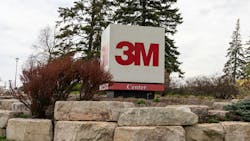3M Refines Operations, Focuses on Core Growth and Product Innovation
3M isn’t done transforming, but it is putting the dynamite away.
After layoffs and the Solventum spinoff created a smaller company in recent years, 3M CEO Bill Brown now wants to take out a chisel to finish carving the Maplewood-based institution into a focused growth machine.
“There won’t be a big bang,” he told analysts last week. “What we’re embarking on now is a more longer-term, more thoughtful redesign.”
Brown, about 18 months into his tenure, is staking his legacy on that slow-and-steady final polish.
“Bill Brown is only the third outside CEO in 3M history, and the prior two ended up being quite unsuccessful,” said RBC analyst Deane Dray. “But if you were filming a movie and wanted a charismatic CEO, that’s Bill Brown. He’s a whirlwind of motion and action and comes from a fabulous background.”
3M has already turned around years of declining innovation, at least by one measure. New product launches — often incremental improvements on existing lines, like the latest Scotch painter’s tape — should add up to a much larger share of overall sales in the coming years.
Right now, about 10% of sales come from products introduced in the past five years. By 2027, that number should be 20%, if 3M hits its goal for 1,000 new product launches.
“We continue to shift resources toward new product development,” Brown told analysts. “And most importantly, we’re beginning to bend the curve on revenue from new products.”
That’s happening without a significant increase in research and development spending — which typically accounts for just under 5% of revenue — as R&D crews previously assigned to removing PFAS from products set their minds on new products.
Even without inventing the next Post-it note, Brown said the incremental launches shape “customer perception that innovation is back at 3M.”
At the same time, the company will shed a chunk of its 120 major business lines to focus on only the strongest “profit centers,” as Brown calls them.
“About 10% of that portfolio are in more commodity areas where they may no longer be a strong fit for the company, where we don’t have a clear right to win,” Brown said. “To build a 3M that’s higher performance, higher growth ... not every business we’re in today will be part of that journey going forward.”
3M this fall struck a deal to sell an industrial precision grinding and finishing business that represents less than 1% of total sales but has seven underutilized factories dedicated to it.
“So you can imagine what the profitability of the business happens to be,” Brown said.
The gradual new-product gains and portfolio shaping, and surprising recent sales growth, have analysts celebrating “a material change in the narrative,” wrote Stephen Tusa at J.P. Morgan.
Julian Mitchell at Barclays wrote “the company looks very well set to continue on its self-help path into and beyond 2026.”
A stock price up 29% so far this year has rewarded shareholders’ patience.
Brown’s strategy also serves to redirect attention from 3M’s PFAS problem, as the company might still be on the hook for billions in future settlements for the “forever chemicals.”
“There is progress in a multi-year turnaround,” Dray said. “We’re just concerned there is still this black cloud of PFAS that is going to create headline risk.”
A judge postponed a bellwether trial scheduled to begin this month to allow for more filed cases.
Brown spends little time discussing PFAS, and on last week’s earnings call, he waited for a question to give an update. He also hasn’t spoken publicly via the media. The 63-year-old instead prefers to let 3M’s work speak for itself.
©2025 The Minnesota Star Tribune. Visit startribune.com. Distributed by Tribune Content Agency, LLC
